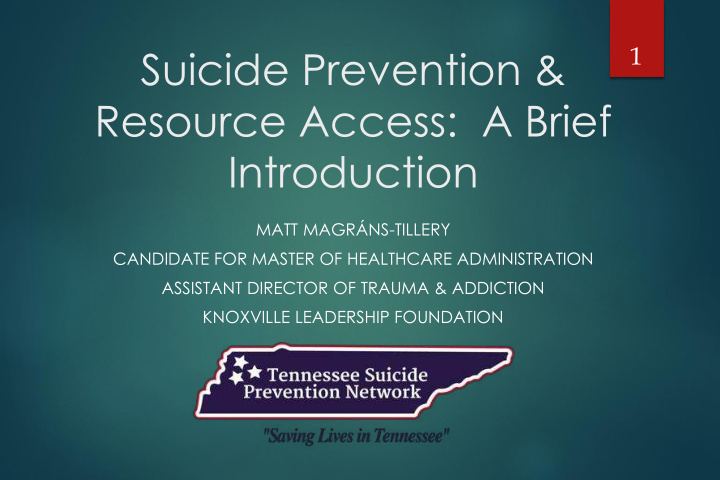



1 Suicide Prevention & Resource Access: A Brief Introduction MATT MAGRÁNS-TILLERY CANDIDATE FOR MASTER OF HEALTHCARE ADMINISTRATION ASSISTANT DIRECTOR OF TRAUMA & ADDICTION KNOXVILLE LEADERSHIP FOUNDATION
Facts About Suicide 2 47,173 people died by suicide in 2017 in the United States. 1,110 people died by suicide in 2016 in Tennessee. 1,163 people died by suicide in 2017 in Tennessee. Approximately 5% of the population (330,015 people) had thoughts of suicide in Tennessee in 2015. Over 1 million people attempt suicide each year, according to a recent SAMHSA study. CDC/AFSP/AAS
Facts About Suicide 3 Suicide is the 10 th leading cause of death for all age groups. Suicide is the 2 nd leading cause of death for ages 15-24. Someone dies by suicide approximately every 12 minutes. Someone aged 10-24 dies by suicide approximately every 1 hour and 48 minutes. Suicide is now the 1 st leading cause of death for ages 10-24. CDC/AAS
Tennessee Youth Risk 4 Behavior Survey 2015 16% considered suicide 14.2% made plans 9.9% made an attempt 3.8% made an attempt medical attention
2017 Rates Of 5 Suicide/100,000/Year National rate = 14.5 Tennessee rate = 17.4 AFSP/TDOH
Suicide in East Tennessee 6 COUNTY 2014 2015 2016 2017 COUNTY 2012 2013 2014 2015 2016 Anderson 8 (10.6) 19 (25.1) 9 (11.9) 16 (21.1) 17 (22.4) Anderson 9 (11.9) 16 (21.1) 17 (22.4) 11 (14.4) Blount 14 (11.3) 25 (20.0) 15 (11.9) 14 (11.0) 27 (21.0) Blount 15 (11.9) 14 (11.0) 27 (21.0) 29 (22.3) Campbell 6 (14.8) 8 (19.9) 6 (15.0) 6 (15.1) 7 (17.6) Campbell 6 (15.0) 6 (15.1) 7 (17.6) 10 (25.2) Claiborne 10 (31.1) 10 (31.7) 8 (25.3) 8 (25.2) 11 (34.6) Claiborne 8 (25.3) 8 (25.2) 11 (34.6) 6 (19.0) Cocke 7 (19.7) 6 (16.9) 7 (19.8) 13 (37.0) 8 (22.7) Cocke 7 (19.8) 13 (37.0) 8 (22.7) 6 (16.9) Grainger 7 (30.9) 3 (13.2) 6 (26.3) 3 (13.1) 5 (21.7) Grainger 6 (26.3) 3 (13.1) 5 (21.7) 1 (4.3) Hamblen 9 (14.3) 16 (25.4) 6 (9.5) 19 (30.0) 21 (32.9) Hamblen 6 (9.5) 19 (30.0) 21 (32.9) 10 (15.6) Jefferson 9 (17.2) 5 (9.6) 4 (7.6) 6 (11.3) 9 (16.8) Jefferson 4 (7.6) 6 (11.3) 9 (16.8) 9 (16.7) Knox 77 (17.4) 57 (12.8) 66 (14.7) 67 (14.8) 72 (15.8) Knox 66 (14.7) 67 (14.8) 72 (15.8) 83 (18.0) Loudon 8 (16.1) 6 (11.9) 12 (23.6) 11 (21.5) 4 (7.8) Loudon 12 (23.6) 11 (21.5) 4 (7.8) 6 (11.5) Monroe 9 (19.9) 7 (15.5) 6 (13.3) 11 (24.0) 13 (28.3) Monroe 6 (13.3) 11 (24.0) 13 (28.3) 8 (17.3) Morgan 4 (18.2) 3 (13.7) 2 (9.2) 6 (27.9) 7 (32.5) Morgan 2 (9.2) 6 (27.9) 7 (32.5) 4 (18.5) Roane 13 (24.3) 16 (30.2) 9 (17.1) 14 (26.5) 12 (22.7) Roane 9 (17.1) 14 (26.5) 12 (22.7) 19 (35.8) Scott 4 (18.1) 2 (9.1) 6 (27.3) 5 (22.8) 9 (41.0) Scott 6 (27.3) 5 (22.8) 9 (41.0) 9 (40.9) Sevier 17 (18.4) 16 (17.1) 19 (20.0) 18 (18.8) 20 (20.7) Sevier 19 (20.0) 18 (18.8) 20 (20.7) 29 (29.7) Union 5 (26.2) 5 (26.2) 6 (31.4) 5 (26.2) 9 (47.0) Union 6 (31.4) 5 (26.2) 9 (47.0) 4 (20.6) TENNESSEE 956 (14.8) 1,017 (15.7) 945 (14.4) 1,065 (16.1) 1,110 (16.2) TENNESSEE 945 (14.4) 1,065 (16.1) 1,110 (16.2) 1,163 (17.3) AFSP/TDOH
7
8
Sri Lanka & Pesticides 9 Suicide by ingestion of pesticides is among leading causes of death Mid- to Late-1990s, restrictions placed on sales of most highly human- toxic pesticides Suicide rates dropped 50% from 1996 to 2005 Saving the lives of 20,000 persons during the given time period Nonfatal poisonings and suicides by other means had no decreases Source: Gunnell 2007, International Journal of Epidemiology
United Kingdom & 10 Domestic Gas Prior to 1960, domestic gas was leading cause of suicide death in the UK By 1970, nearly all domestic gas in the UK was non-toxic Suicide rates dropped by nearly one-third Non-gas suicides slightly increased Source: Kreitman 1976, British Journal of Preventive & Social Medicine
Means Matters 11 Suicidal crises are often relatively brief Most persons with lived experiences took actions quickly and with little planning 90% of those who survive even nearly-lethal lived experiences do not go on to later die by suicide See: www.meansmatter.org
Gender and Suicide - 2016 12 Men are nearly 4 times more likely to die by suicide than women. Women attempt suicide 3 times as often as men. Deaths by Gender, 2016 23% Males 77% Females
Reducing Stigma 13 Introduction to resources Referrals to Behavioral Health Providers with lived experiences Being advocates for and stewards of prevention in our own communities
Tennessee Suicide Prevention 14 Network Prevention QPR – Question, Persuade, Refer 1-3 Hour training Intended to offer hope, not a form a counseling or treatment Gatekeepers ASIST – Applied Suicide Intervention Skills Training Two-Day training Comprehensive & based on skills building Mental Health First Aid 8 Hour training Assist persons with ongoing or acute MH problems
Tennessee Suicide Prevention 15 Network Postvention Postvention Team Schools Business Offices Skilled Nursing Facilities College Campus Groups Community Mental Health Centers
Policies & Procedures 16 Quality Improvement Teams Departmental Strategies Systems Strategies What to say vs. What not to say Development Implementation
Questions? 17 www.TSPN.org Matt Magráns-Tillery mtillery@klf.org 865-607-8561
Recommend
More recommend